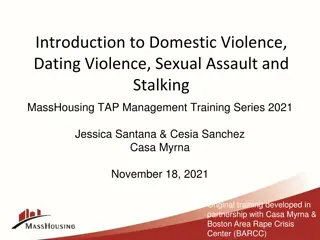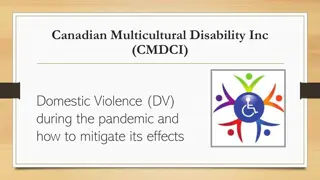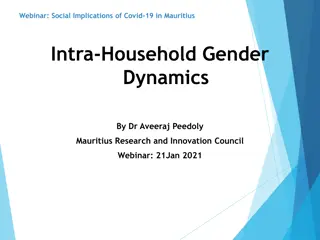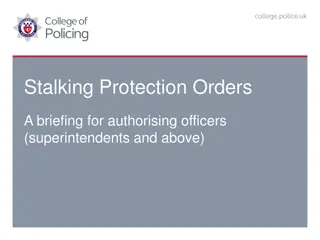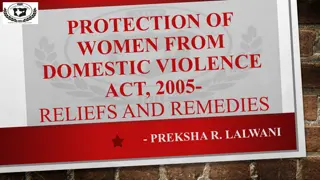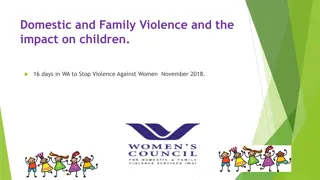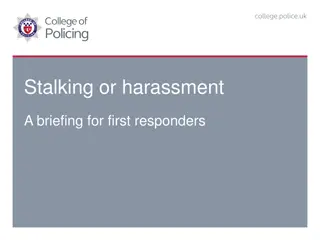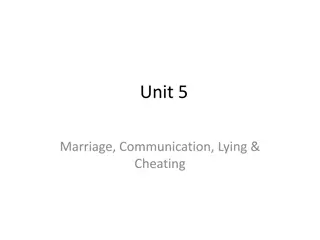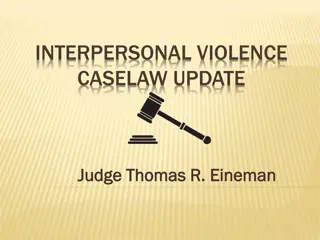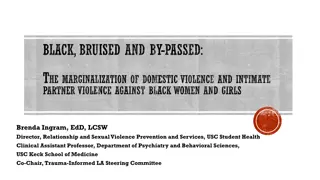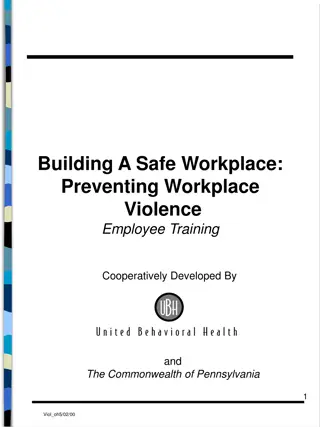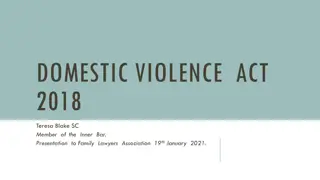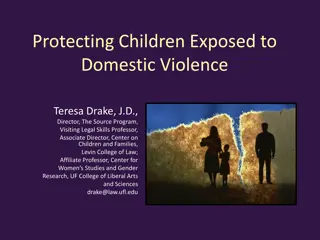
Domestic Violence and Stalking Crimes for Law Enforcement
Explore the legislative responsibilities of law enforcement in addressing domestic violence since 1985. Learn about the statutory relationships and listed acts involved in domestic violence cases, including battery, assault, stalking, and more. Enhance your knowledge to effectively assist victims and take appropriate action.
Download Presentation

Please find below an Image/Link to download the presentation.
The content on the website is provided AS IS for your information and personal use only. It may not be sold, licensed, or shared on other websites without obtaining consent from the author. If you encounter any issues during the download, it is possible that the publisher has removed the file from their server.
You are allowed to download the files provided on this website for personal or commercial use, subject to the condition that they are used lawfully. All files are the property of their respective owners.
The content on the website is provided AS IS for your information and personal use only. It may not be sold, licensed, or shared on other websites without obtaining consent from the author.
E N D
Presentation Transcript
Performance Objectives NAC: 289. 140 150 170 200 Please refer to your POST Performance Objectives.
Unit Goal To develop an understanding of domestic violence and stalking crimes, the appropriate action to take, and the techniques for assisting victims.
Introduction Since 1985 the Legislature has systematically increased law enforcement s responsibility to intervene, resolve, and document incidents of domestic violence. To effectively perform these tasks, the peace officer needs to be able to recognize domestic violence and apply the appropriate laws.
Domestic Violence Domestic violence means a listed act committed upon an adult or minor where there exists a statutory relationship between the victim and the suspect. The required relationship must be one or more of the following;
Domestic Violence Spouse Former spouse Relative by blood or marriage Any person with whom the victim is or was actually residing Anyone they have had or are having a dating relationship With anyone they have a child in common The minor child of any of the above Their own minor child or; The legal guardian or custodian of the persons minor child
Domestic Violence With one or more of the relationships listed, the suspect commits one or more of the following acts; Battery Assault Compelling the other person by force or threat of force to perform an act from which the other person has the right to refrain or to refrain from an act which the other person has the right to perform. sexual assault.
Domestic Violence A knowing, purposeful or reckless course of conduct intended to harass the other person. Such conduct may include, but is not limited to: Stalking Arson Trespassing Larceny Destruction of property Carrying a concealed weapon without a permit Injuring or killing an animal False imprisonment Unlawful entry of the other person s residence, or forcible entry against the other person s will if there is a reasonably foreseeable risk of harm to the other person from the entry.
Dating Relationship Dating relationship means frequent, intimate associations primarily characterized by the expectation of affectional or sexual involvement. The term does not include a casual relationship or an ordinary association between persons in a business or social context.
Domestic disputes vs. Domestic violence Domestic disputes are not the same as domestic violence. Domestic disputes are disagreements between family or household members that do NOT involve violence, threats of violence, or court order violations.
Identify the Impact of Domestic Violence Domestic violence causes tremendous harm to victims and society as a whole. Each member in an abusive or violent household suffers physically and/or emotionally, and often violence is spread from one generation to the next.
Identify the Impact of Domestic Violence Domestic violence usually involves a pattern of increasingly frequent and severe assaultive and abusive behavior that is used against intimate partners; Its purpose is to control the victim and other members of the household. The pattern may include physical, sexual, and psychological attacks as well as economic coercion
Identify the Impact of Domestic Violence Domestic violence is not a private family matter; it is serious, often criminal conduct and should be treated as such. Peace officers play a critical role in erasing myths about domestic violence, increasing victim safety, stopping the violence, and holding abusers accountable.
Batterer and Victim Characteristics Batterers use a variety of tactics to gain power and control over intimate partners. Some, like physical and sexual violence, are only used occasionally. Some are used one or more times every day. These include:
Batterer Intimidation Emotional abuse Isolation Minimizing, denying, and blaming Using children Economic abuse Coercion and threats
Batterer Characteristics May have low self-esteem As a child, often witnessed or experienced violence Avoids responsibility for violent behavior by blaming: children work victim or others drugs or alcohol Often afraid, jealous, and/or obsessed with controlling a partner s activities
Victim Characteristics May have physical injuries including injuries from sexual assault May have low self-esteem Suffers emotional trauma As a child, often witnessed or experienced violence Fears further violence to self or family members
Victim Characteristics (Children) Often learn that violence is an acceptable and expected part of relationships May have low self-esteem Often learn to use violence to express frustration, anger, or needs May blame themselves for the violence
Domestic Violence Effect on Children Children are affected by domestic violence, even if they are not the direct target of the abuse. Even though children are not directly abused, the effects of witnessing violence, especially by one parent against the other parent, is traumatic and may lead to the development of Post-Traumatic Stress Disorder
Domestic Violence Effect on Children This abuse may also constitute child endangerment under certain circumstances. Children can act out learned behavior, resulting in new problems. They may take on the role of protecting the victim and other siblings. The need to provide protection may lead the child to mimic destructive or violent behavior.
Domestic Violence Effect on Children Nationally, Child Protective Services (CPS) organizations have determined that children who witness domestic violence are victims of child abuse. In Nevada, CPS has stated that witnessing severe domestic violence is child abuse.
Victim reasoning The thought process of domestic violence victims may be difficult for a peace officer to understand. Though they may be emotionally, physically, and/or sexually abused, victims often remain in the home with the perpetrator or return if they have initially left.
Myth Battering only happens in poor, uneducated families. If a woman stays, then she deserves it. Wives don t batter husbands. Batterer is not a loving person.
Reality Battering occurs in families at all economic and social levels. Many women attempt to leave, but are physically stopped, stalked, or otherwise located by their abusive partner. While men are certainly battered, their rate of reporting is very low. Men are reluctant to report domestic violence for fear or ridicule or embarrassment. Batterers often appear loving after a violent episode and beg for forgiveness; they promise it will not happen again. Batterers often have good qualities.
Peace Officer impact Repeated responses to domestic violence calls at a household where the victim will not leave can be frustrating for peace officers. However, it is critical for peace officers to recognize that simply responding to these calls has an impact on all the individuals in the household. Generally, arrest of the batterer is one of the most effective deterrents in preventing continued violence.
Acts Constituting Domestic Violence Battery means any willful and unlawful use of force or violence upon the person of another. In domestic violence situations the battery must be upon someone who meets the relationship requirement.
Acts Constituting Domestic Violence Whether or not a warrant has been issued, a peace officer shall, unless mitigating circumstances exist, arrest a person when the peace officer has probable cause to believe that the person to be arrested has, within the preceding 24 hours, committed a battery on a person where the requisite relationship exists.
Domestic violence convictions First offense within 7 years, is guilty of a misdemeanor and shall be sentenced to: Imprisonment in the city or county jail or detention facility for not less than 2 days, but not more than 6 months; and Perform not less than 48 hours, but not more than 120 hours, of community service.
2ndOffense Second offense within 7 years, is guilty of a misdemeanor and shall be sentenced to: Imprisonment in the city or county jail or detention facility for not less than 10 days, but not more than 6 months; and Perform not less than 100 hours, but not more than 200 hours, of community service.
3rdOffense For the third and any subsequent offense within 7 years, is guilty of a category C felony and shall be punished as provided in NRS 193.130.
Assault Where the requisite relationship exists and the suspect: Unlawfully attempts to use physical force against another person; or Intentionally places the other person in reasonable apprehension of immediate bodily harm. The suspect is guilty of assault and domestic violence
Sexual Assault Where the requisite relationship exists and the suspect: Subjects another person to sexual penetration, or forces another person to make a sexual penetration on himself or herself or another, or on a beast, against the will of the victim or under conditions in which the perpetrator knows or should know that the victim is mentally or physically incapable of resisting or understanding the nature of his or her conduct; or
Sexual Assault Commits a sexual penetration upon a child under the age of 14 years or causes a child under the age of 14 years to make a sexual penetration on himself or herself or another, or on a beast. The suspect is guilty of sexual assault and domestic violence.
Force or threat to perform an unwilling act Where the requisite relationship exists and the suspect: Physically forces (possible battery) or by threat forces, the victim to perform and act they have a right to refuse, or refrain from an act they have a right to complete. This could include everything from financial concerns, i.e. sign loan papers, close bank accounts, to issues related to child care and custody. Suspect may be guilty of domestic violence, but also may be guilty of the underlying act where it is criminal in nature.
Harassment Where the request relationship exists and the suspect; Engages in an intention or reckless course of conduct Intended to harass (see definition of harassment below).
False Imprisonment Where the requisite relationship exists and the suspect: Confines or detains the victim without legal authority by the suspect Suspect is guilty of domestic violence and false imprisonment.
Unlawful or Forcible Entry into Residence Where the requisite relationship exists and the suspect: Enters the victim s residence and there is a reasonable and foreseeable risk of harm
Requirement under the law In general police officers may exercise discretion in terms of arrest. Due to the unique nature of domestic violence crimes involving victims and other influences, officer discretion is suspended and arrests are mandated in specific situations.
Identifying the Primary Aggressor Some factors to consider when determining the primary; Injury type and location (defensive wounds) Injuries consistent with statement Victim demeanor. Prior calls for service. History of suspect. Witness statements.
When an Arrest is Mandatory Where the officer determines that a domestic violence battery has occurred, he/she is required to take the primary aggressor into custody. Under the law, officers shall make an arrest when; The domestic violence act is a battery and; The battery has occurred within the last 24 hours and; The officer has determined the primary aggressor,
When an Arrest is Mandatory If the peace officer has probable cause to believe that a domestic violence battery was a mutual battery, the peace officer shall attempt to determine which person was the primary physical aggressor. If the peace officer determines that one of the persons who allegedly committed a battery was the primary physical aggressor involved in the incident, the peace officer is not required to arrest any other person believed to have committed a battery during the incident.
Actions Regarding the Domestic Violence Scene When peace officers respond to a domestic violence call, it is essential that they proceed cautiously to ensure the protection of all people involved. Domestic violence calls create a dangerous situation that must be handled with great caution and attention to safety
Actions Regarding the Domestic Violence Scene When peace officers respond to a domestic violence call, it is essential that they proceed cautiously to ensure the protection of all people involved. Based on simple volume and the volatile/ emotional nature of the incident, historically, domestic violence calls result in more injuries and death to peace officers than any other calls for service.
Before entering Before entering, peace officers should consider the following guidelines: Coordinate units and plan of approach Request additional (backup) officers if necessary, and Confirm the address Attempt to obtain a history of calls to the location
Before entering Attempt to obtain a history of the parties, including mental health flags Make a tactical and undetected approach to the scene Observe the surroundings Stand to the side of the door and listen Attempt to determine how many people are involved Try to determine the nature of the dispute Try to determine the level of aggression Knock and identify themselves as peace officers
Scene Security Upon entering the premises, peace officers should: Locate and identify all parties in the residence Make a protective sweep of the location, if warranted Scan and take control of any weapons Take control of the scene Determine who else is at the location Determine if medical assistance is required Request additional (backup) officers, if necessary

